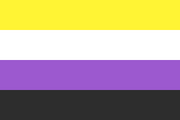
the nonbinary flag
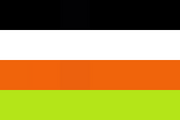
the oldest known nonbinary flag
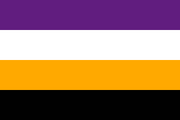
an alternate nonbinary flag
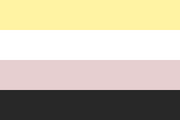
another alternate nonbinary flag
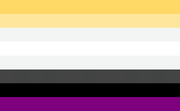
an alternate 8-stripe nonbinary flag
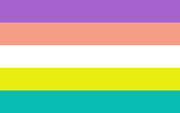
Kirbirb's 5-stripe nonbinary flag
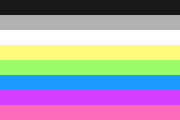
Waterbutcold's 8-stripe nonbinary flag
Non-binary (often stylized as nonbinary and sometimes shortened to NB or enby) refers to someone whose gender does not fall strictly within the category of the binary genders (man or woman) that are used in western society. Anyone who is not always, solely, 100% male or always, solely, 100% female can be considered non-binary. Some non-binary people may identify with one or both of the binary genders, at least in part, while others are completely unrelated to the binary genders.
Non-binary can be a gender identity on its own, or it can be used as an umbrella term for anyone whose gender is something other than male or female.
Non-binary people may call themselves enbies or borls (the equivalent of boys or girls) or enben (the equivalent of men or women).[1][2] Non-binary is included in the umbrella of transgender, although some non-binary people choose not to identify as transgender.
Non-binary Identities[]
One may identify as non-binary on its own or they may identify as a gender that falls in the category of non-binary. Any gender that is not strictly and completely male or strictly and completely female falls under the category of non-binary. Some common examples of non-binary identities include:
- Agender
- Androgyne
- Bigender
- Demigender
- Genderfluid
- Genderflux
- Libragender
- Maverique
- Neutrois
- Paragender
Types of Non-Binary Genders[]
Some non-binary people can be partly connected to or aligned with one or both of the binary genders. For example, a man-aligned non-binary person (solarian) may have an experience similar to man or have some connection to manhood, but is not a man or is not fully a man. Non-binary people may also be connection to masculinity and/or femininity, but they do not necessarily have to be connected to manhood or womanhood. These types of non-binary identities can be called viabinary, ideobinary, or aligned. Non-binary people who are in between or simultaneously experience masculinity and femininity, and/or maleness and femaleness can be called androgyne, androgynous, or mesobinary.
Other non-binary genders are not connected to the binary genders at all. These genders are not connected to maleness, masculinity, femaleness, femininity, and they are not in between male and female or in between masculine and feminine. However, these genders are also not necessarily a lack of gender or agender. These genders can be called abinary, unaligned, neutral, neutral-aligned, epicene, or exobinary.
Non-binary people who are not female aligned, feminine aligned, male aligned, masculine aligned, or neutral aligned are called atrinary, outherine. Many outherine genders are also xenogenders.
Transition[]
Since there is no single "non-binary look", there is no "typical" non-binary transition, it depends on the person's individual gender identity and their goals for gender presentation. Some non-binary people do not transition and present as the gender assigned to them at birth, others may attempt to look like the "opposite" of their assigned gender, as more masculine or feminine. Others will attempt to look as androgynous or gender neutral as possible.
Some non-binary people may socially transition but do not medically transition. Other non-binary people may take elements of binary transgender transitions. For example, an AFAB (assigned female at birth) non-binary person may take testosterone, or wear a binder. They may only desire a "partial" transition in order to look androgynous.
Pronouns[]
Each non-binary person has a unique relationship with pronouns. If their language has gender neutral pronouns, such as they/them, they may use those. Some non-binary people may go by she/her pronouns or he/him pronouns. Others will go by it/its pronouns (though, this should only be used if someone asks, as otherwise it is dehumanizing). Others still will go by neopronouns. Many non-English speakers will create neopronouns, as their language does not have a gender-neutral singular pronoun like the English "they". Additionally, some may go by multiple pronoun sets, and others will go by no pronouns, using just a name in place of where pronouns would be.
History[]
Ancient History[]
The existence of non-binary people has been recorded by many cultures throughout history. Many non-western cultures recognized three or sometimes more genders, dating back to antiquity, however the existence of these genders was often suppressed during colonization.
- Some of the earliest recorded instances of non-binary people come from Mesopotamia. In Mesopotamian mythology, there are references to the types of people who are not men and not women. Many priests or individuals who preformed religious duties were described as a third gender.
- The Māhū in Kanaka Maoli (Hawaiian) cultures are third gender persons that traditionally played spiritual roles within the culture. The first written Western description of māhū occurs in 1789, by Captain William Bligh. When stopped in Tahiti he was introduced to a member of a "class of people very common in Otaheitie called Mahoo... who although I was certain was a man, had great marks of effeminacy about him."
- The Buddhist Tipitaka documents four gender categories: female, male, ubhatobyanjanaka (people with both male and female characteristics), and pandaka (a complex term with no English translation).
- Prior to Western contact, some Native American tribes had third-gender roles. European anthropologists usually referred to these people as "berdaches", which Natives considered a slur. In 1990, some Indigenous North Americans adopted the term two-spirit.
- Across the Indian subcontinent there are several similar gender identities that are collectively known as hijra in English. Hijra is neither completely male nor female, but they typically have a feminine gender expression.
- Jewish sacred texts recognize six genders: zachar (cisgender men), nekeivah (cisgender women), ay'lonit (transgender men), saris (transgender women), androgynos (someone with both male and female characteristics, roughly equivalent to androgyne or bigender), and tumtum (someone whose sex is indeterminate or obscured, roughly equivalent to agender).
- Bissu is a gender from the Bugis culture of southern Indonesia which represent all aspects of gender combined to form a whole. They play an important role in religious ceremonies among those who practice the pre-Islamic religion of the area. Traditionally the Bugis recognized five genders, and believed that all five genders must live in harmony for there to be peace in the world.
Victorian Era (17th-19th Century)[]
- In the 17th century, English laws concerning inheritance sometimes referred to people who didn’t fit the gender binary using the pronoun "it". While dehumanizing, it was considered the most grammatically fit answer to gendered pronouns around then. This is an example of people being considered legally outside of male and female.[3]
- Although the "singular they" had been in use in English for hundreds of years in 1745, prescriptive grammarians began to say that it was no longer acceptable. Their reasoning was that neutral pronouns don't exist in Latin, which was thought to be a better language, so English shouldn't use them either. They instead recommended using "he" as a gender-neutral pronoun. This started the dispute over the problem of acceptable gender-neutral pronouns in English.[4]
- The Public Universal Friend (1752-1819) was a genderless evangelist who traveled throughout the eastern United States to preach a theology based on that of the Quakers, which was actively against slavery. The Friend was reanimated by God from a severe illness at age 24 with a new spirit, according to the Friend, which was genderless. The Friend refused to be called by the birth name, even on legal documents, and insisted on being called by no pronouns. Followers respected these wishes, avoiding gender-specific pronouns even in private diaries, and referring only to "the Public Universal Friend", "the Friend" or "P.U.F." The Friend wore clothing that contemporaries described as androgynous, which were usually black robes.[5]
Modern History[]
- The earliest known use of the word "genderqueer" is by Riki Anne Wilchins in the Spring 1995 newsletter of Transexual Menace. In 1995 they were published in the newsletter In Your Face, wherethey used the term genderqueer In the newsletter, the term appears to refer to people with complex or unnamed gender expressions. Wilchins stated they identify as genderqueer in their 1997 autobiography.[6]
- In 1998, an article from a transgender community on the Internet, Sphere, used the words "queergendered" and "polygendered" interchangeably as umbrella terms for everyone whose gender was outside the gender binary, specifying that these included people who were "bi-gendered, non-gendered, or third-gendered," explaining that some faced difficulty in seeking a gender-ambiguous physical transition.[7]
Flag and Symbols[]
The non-binary flag was created by Kye Rowan in February of 2014. It was designed for non-binary people who felt the genderqueer flag did not represent them.[8] Yellow represents being outside the gender binary, as yellow is often used to distinguish something as its own. White is the presence of all colors, representing people who are many or all genders. Purple represents the fluidity and multiplicity of many gender experiences, the uniqueness and flexibility of non-binary people, as well as representing those whose gender experiences include being in between female (traditionally pink) and male (traditionally blue). Black is the absence of color and represents agender or genderless people.
The alternate non-binary flag was created on the LGBTA Fandom Wikia by user Blueberryjello on December 17, 2020. The yellow signifies someone who is not cisgender, the white signifies those who identify as multigender, the black signifies being agender, and the green signifies someone who is without reference to binary[9].
Another alternate was created by wiki user Kirbirb on February 11th, 2021. It was made to be more inclusive than the most common flag. Purple is for androgynous genders and xenogenders, peach is for feminine-aligned and female-aligned genders, white is for both all genders and genderlessness, yellow is for abinary and unaligned genders, and teal is for masculine-aligned and male-aligned genders.
The most common non-binary symbol was created by Johnathan R in 2012.[10] It is similar to the male or female symbols, but instead of a cross on the female symbol or arrow on the male symbol, it uses an X or a star on the end. The use of the X denounces both binary genders, and the letter X is commonly used in non-binary pronouns and titles. The position, pointing straight up, also deviates from the positions of the male and female symbols.
Another non-binary flag was coined by Cryptocrew at Hayden000's request on January 15, 2021 and was first published on a post two days later. In the background of the flag, dark blue is for man-aligned non-binary people, light blue is for masculine-aligned non-binary people, green is for genderless/agender-aligned non-binary people, white is for fluid-aligned non-binary people, purple is for multigender non-binary people, orange is for xenic/outherine-aligned non-binary people, pink is for feminine-aligned non-binary people, and red is for woman-aligned non-binary people. In the front, the black is for falling out of the binary, while the purple crossing off the pink and blue represents being seperate from a man or a woman.
Another non-binary flag was designed on April 9, 2021 by FANDOM user Waterbutcold. The black represents being genderless, blank genders, null genders and absence of gender, the gray represents partial genders, the white represents multigenders, fluid, and flux genders, the yellow represents unique and abinary genders, and the green represents neutral genders. The blue represents masculine and male genders, as well as masculine gender presentation. This includes being male-aligned, linked with masculinity, connected with it, or having aspects of a masculine/male gender. The purple represents male and female, feminine and masculine, and androgynous genders, as well as androgynous gender presentation. This includes every gender that's linked, aligned, or connected to both binary genders in any way. It includes having aspects of both binary genders. The pink represents feminine and female genders, as well as feminine gender presentation. This includes being female-aligned, linked with femininity, connected with it, or having aspects of a feminine/female gender.
The astronomical symbol for comets (☄) is also sometimes used as a non-binary symbol. It was proposed because the male and female signs are both signs for planets. The symbols for comets was likely chosen because comets can exist anywhere in the solar system, showing the vast range of possible non-binary identities. This symbol is also sometimes used for maverique specifically.
Gallery[]
Trivia[]
Non-binary has the color association of yellow.[11]
Resources[]
- ↑ https://askanonbinary.tumblr.com/post/74102698117/okay-everyone-i-want-your-input-on-this-were
- ↑ Glossary of English gender and sex terminology | Nonbinary Wiki
- ↑ https://www.merriam-webster.com/words-at-play/singular-nonbinary-they
- ↑ Our Desperate, 250-Year-Long Search for a Gender-Neutral Pronoun | The Awl
- ↑ https://en.wikipedia.org/wiki/Public_Universal_Friend
- ↑ https://genderqueerid.com/post/8813994851/answering-gender-questions-coining-genderqueer
- ↑ http://gender-sphere.0catch.com/polygenderfaq.htm
- ↑ https://thejasmineelf.tumblr.com/post/77007286542/after-counting-up-all-the-votes-for-each
- ↑ https://lgbta.wikia.org/f/p/4400000000000051180
- ↑ https://genderqueerid.com/post/27216986889/cakemeister-because-people-seem-to-like-it
- ↑ https://pupyzu.tumblr.com/post/652392908871385088/gender-orientation-color-associations